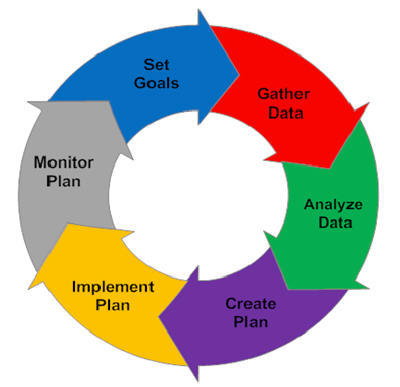Planning is the first primary function of management that precedes all other functions. The planning function involves the decision of what to do and how it is to be done? So managers focus a lot of their attention on planning and the planning process. Let us take a look at the eight important steps of the planning process.
Suggested Videos
Planning Process
The planning function of management is one of the most crucial ones. It involves setting the goals of the company and then managing the resources to achieve such goals. As you can imagine it is a systematic process involving eight well thought out steps. Let us take a look at the planning process.

1] Recognizing Need for Action
An important part of the planning process is to be aware of the business opportunities in the firm’s external environment as well as within the firm. Once such opportunities get recognized the managers can recognize the actions that need to be taken to realize them. A realistic look must be taken at the prospect of these new opportunities and SWOT analysis should be done.
Say for example the government plans on promoting cottage industries in semi-urban areas. A firm can look to explore this opportunity.
2] Setting Objectives
This is the second and perhaps the most important step of the planning process. Here we establish the objectives for the whole organization and also individual departments. Organizational objectives provide a general direction, objectives of departments will be more planned and detailed.
Objectives can be long term and short term as well. They indicate the end result the company wishes to achieve. So objectives will percolate down from the managers and will also guide and push the employees in the correct direction.
Importance, Features, and Limitation of Planning here in detail.
3] Developing Premises
Planning is always done keeping the future in mind, however, the future is always uncertain. So in the function of management certain assumptions will have to be made. These assumptions are the premises. Such assumptions are made in the form of forecasts, existing plans, past policies, etc.
These planning premises are also of two types – internal and external. External assumptions deal with factors such as political environment, social environment, the advancement of technology, competition, government policies, etc. Internal assumptions deal with policies, availability of resources, quality of management, etc.
These assumptions being made should be uniform across the organization. All managers should be aware of these premises and should agree with them.
4] Identifying Alternatives
The fourth step of the planning process is to identify the alternatives available to the managers. There is no one way to achieve the objectives of the firm, there is a multitude of choices. All of these alternative courses should be identified. There must be options available to the manager.
Maybe he chooses an innovative alternative hoping for more efficient results. If he does not want to experiment he will stick to the more routine course of action. The problem with this step is not finding the alternatives but narrowing them down to a reasonable amount of choices so all of them can be thoroughly evaluated.
5] Examining Alternate Course of Action
The next step of the planning process is to evaluate and closely examine each of the alternative plans. Every option will go through an examination where all there pros and cons will be weighed. The alternative plans need to be evaluated in light of the organizational objectives.
For example, if it is a financial plan. Then it that case its risk-return evaluation will be done. Detailed calculation and analysis are done to ensure that the plan is capable of achieving the objectives in the best and most efficient manner possible.
6] Selecting the Alternative
Finally, we reach the decision making stage of the planning process. Now the best and most feasible plan will be chosen to be implemented. The ideal plan is the most profitable one with the least amount of negative consequences and is also adaptable to dynamic situations.
The choice is obviously based on scientific analysis and mathematical equations. But a managers intuition and experience should also play a big part in this decision. Sometimes a few different aspects of different plans are combined to come up with the one ideal plan.
7] Formulating Supporting Plan
Once you have chosen the plan to be implemented, managers will have to come up with one or more supporting plans. These secondary plans help with the implementation of the main plan. For example plans to hire more people, train personnel, expand the office etc are supporting plans for the main plan of launching a new product. So all these secondary plans are in fact part of the main plan.
8] Implementation of the Plan
And finally, we come to the last step of the planning process, implementation of the plan. This is when all the other functions of management come into play and the plan is put into action to achieve the objectives of the organization. The tools required for such implementation involve the types of plans- procedures, policies, budgets, rules, standards etc.
Solved Question for You
Q: _______ involves scientific analysis of the decision process
- Linear Programming
- Risk Analysis
- Operations Research
- None of the above
Ans: The correct option is C. Operation research is the application of scientific and mathematical methods to study and analyse problems involving complex systems. It is a powerful tool for decision making.






You made a good point that I should be wary of dynamic situations when dealing with business planning. Nevertheless, I still think that having a good business plan is essential for the game development company that I’m planning to start in the future. Perhaps hiring a business planning consultant would be a good way to have a good footing from the very beginning of the venture.